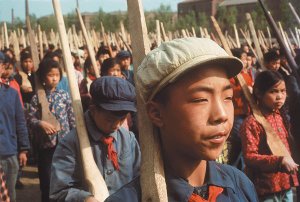Ian Johnson DECEMBER 4, 2014 ISSUE
Remembrance an unofficial journal published in Tiantongyuan, China

Young pioneers on the eve of the Cultural Revolution, 1965; photographs by Marc Riboud, whose exhibition ‘Witness at a Crossroads: Photographer Marc Riboud in Asia’ is at the Rubin Museum of Art, New York City, until March 23, 2015
On the last stretch of flatlands north of Beijing, just before the Mongolian foothills, lies the satellite city of Tiantongyuan. Built during the euphoric run-up to the 2008 Olympics, it was designed as a modern, Hong Kong–style housing district of over 400,000 people, with plentiful shopping and a subway line into Beijing. But it was a rushed job, and planners neglected to put in parks, open spaces, or anything for the public other than roads, which were quickly choked with cars. Construction was pell-mell, and the area has aged quickly, its towers crumbling and cracking.
This rootless suburb is home to Remembrance, an underground journal that deals with one of China’s most sensitive issues: its history. E-mailed to subscribers as a seventy- to ninety-page PDF every other week, Remembrance’s articles and first-person accounts are helping to recover memories that the Communist Party would prefer remained lost. Remembrance has no listed address, let alone bustling editorial offices. But if it has a home, it is here, in one of Tiantongyuan’s concrete apartments, a dark, ground-floor unit lined with bookcases and stacked with boxes of banned books—a fittingly anonymous home for a publication that officially doesn’t exist.
Remembrance is part of the rise of unofficial memory in China, a trend that resembles the appearance in the Soviet Union during the 1980s of groups like Memorial, a historical research society that helped undermine the regime by uncovering its troubled past. Today’s China is more robust than the Gorbachev-era Soviet Union, but memory is still escaping the censor’s grasp, posing challenges to a regime for which history represents legitimacy. The government still controls official history through textbooks, museums, movies, and the media. But memory is more private, and setting it down on paper can be presented as a personal enterprise, even when the outcome is highly political.
Besides Remembrance, China has roughly half a dozen other samizdat publications that explore the past through accounts of personal experience, including Scars of the Past (Wangshi Weihen), Annals of the Red Crag (Hongyan Chunqiu), and Yesterday (Zuotian). In addition, there are a growing number of underground documentary films, including some that send students to collect oral histories in villages that suffered during the Great Leap Famine or the Cultural Revolution.
One Saturday this spring, several of Remembrance’s regular writers stopped by the Tiantongyuan apartment for a pot of Pu’er tea and a chat with the journal’s cofounder, the retired film historian Wu Di. As they arrived, Wu leaned back in his chair and gave a running commentary on each. Among them were a computer data specialist at a technical university (“the greatest specialist on Lin Biao!”), an editor of the Communist Party’s flagship newspaper People’s Daily (“obviously he has to keep a low profile”), and a befuddled professor who had to call Wu three times to get directions (“what an egghead—he knows everything about violence in the Cultural Revolution but doesn’t know how to hail a gypsy cab”).
